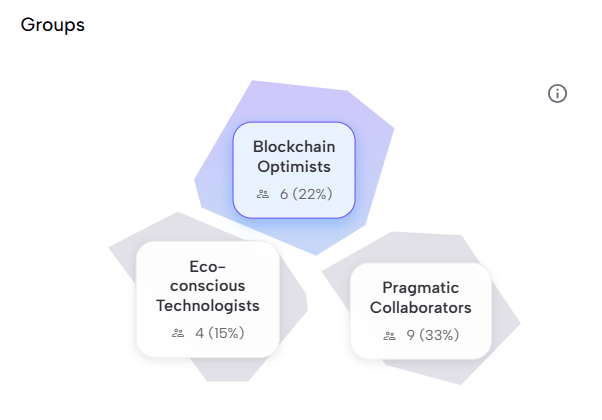Can blockchain technology truly serve conservation, or is it just another tech trend distracting from proven solutions? This was the central tension at Tech4Nature’s Blockchain Innovation Challenge Workshop in 2025, where conservationists, technologists, policymakers, and academics gathered to explore blockchain’s role in environmental protection.
Rather than leaving these questions unresolved, the organizers used Agora Citizen Network to map participant perspectives in real-time during the three-hour online workshop—turning a traditionally polarized debate into a structured conversation that revealed both shared beliefs and constructive disagreements.
The Challenge: Diverse Voices, Complex Questions
The workshop brought together conservation practitioners, technologists, policymakers, academics, and early-career professionals to discuss blockchain applications in:
- Forest and agricultural monitoring transparency
- Verifiable carbon and biodiversity credits
- Direct community funding mechanisms
- Decentralized governance for conservation
Participants came with different levels of technical expertise and varying degrees of optimism about blockchain’s potential. Without a structured way to surface these differences, the conversation could easily have devolved into talking past each other—or worse, been dominated by the loudest voices in the room.
Real-Time Deliberation with Agora
Prior to the workshop, the organizer prepared the conversation on Agora by adding a list of seed opinions—statements to be voted on by participants—representing diverse perspectives.
- At the start of the session, the conversation link and QR code were displayed and distributed, allowing participants to join instantly.
- Throughout the event, the link and QR code were periodically shown on the event screens and shared in the chat during online sessions.
- After each session, the organizer encouraged participation in the livestream chat and shared periodic highlights of emerging consensus and diversity of views.
Throughout the event, 27 participants cast 172 votes on various statements about blockchain in conservation. Unlike a traditional poll, Agora allowed participants to:
- React to each statement with “Agree,” “Disagree,” or “Unsure”
- Submit new statements if their perspective wasn’t represented
- View live results showing areas of consensus and division
This real-time feedback enabled facilitators to identify which topics deserved deeper discussion and which concerns were widely shared—transforming abstract debate into actionable insight.
Key Findings: Where Consensus Meets Disagreement
Top Majority Opinion
85% agree: “Partnerships between conservationists and technologists are key for real-world adoption.”
This overwhelming consensus highlighted that success requires bridging the gap between technical innovation and conservation practice—no single discipline can solve these challenges alone.
Top Cross-Group Consensus
81% agree: “Blockchain can bring transparency to carbon credit markets, reducing fraud.”
While not the absolute majority, this statement revealed the strongest shared belief across different perspectives. Even participants skeptical about blockchain’s broader applications recognized its potential to address trust deficits in carbon markets.
Divisive Issues
Two statements revealed the biggest disagreements:
"Most blockchains consume too much energy and contradict conservation goals."
"Blockchain hype risks distracting from simpler, proven solutions."
These divergent views weren’t problems to solve—they represented legitimate perspectives that needed to coexist in the conversation.
Three Distinct Perspectives Emerged
Agora’s analysis revealed three complementary opinion groups among the participants:

Opinion group analysis from the Tech4Nature Blockchain Workshop on Agora
1. Pragmatic Collaborators (9 people)
- Emphasize that blockchain must not overshadow simpler, proven solutions
- Ensure conservation remains practical and results-oriented
- Most critical of blockchain hype
2. Blockchain Optimists (6 people)
- Confident that blockchain’s benefits outweigh potential drawbacks
- Push for innovation and experimentation
- Most optimistic about blockchain’s transformative potential
3. Eco-Conscious Technologists (4 people)
- Concerned about blockchain’s environmental footprint
- Believe in blockchain’s necessity despite sustainability concerns
- Hold a moderate position between optimism and pragmatism
Unclustered participants (8 people) didn’t fit neatly into any group—they either held unique combinations of views or hadn’t voted on enough statements to reveal a clear pattern.
Why This Matters
By making these different perspectives visible, Agora transformed what could have been a polarized debate into a nuanced conversation. Instead of arguing over whether blockchain is “good” or “bad” for conservation, participants could see:
- Where broad agreement existed (collaboration is essential)
- Which applications had the most support (carbon market transparency)
- What legitimate concerns remained (energy consumption, hype cycles)
This clarity allowed the workshop to focus on productive questions: How can we ensure blockchain applications are genuinely green? What governance models prevent technology from overshadowing conservation priorities? How do we build the partnerships needed for real-world adoption?
Key Takeaways
Shared belief: Technologists and conservationists should collaborate more. Blockchain has real potential to strengthen trust and transparency.
Key trends:
- Optimists push innovation forward
- Pragmatists keep efforts grounded in proven practices
- Eco-conscious technologists ensure sustainability remains central
There’s clear momentum for blockchain in conservation, but its success depends on collaboration, transparency, and commitment to greener advancement.
Looking Forward
The Tech4Nature workshop demonstrated that structured digital deliberation can help communities navigate complex, technical debates without sacrificing nuance or inclusivity. By revealing both consensus and constructive disagreement, Agora helped participants understand not just what people think, but why different perspectives matter.
As conservation continues to explore emerging technologies, tools like Agora ensure these conversations remain grounded in diverse expertise—and that innovation serves the communities and ecosystems it aims to protect.